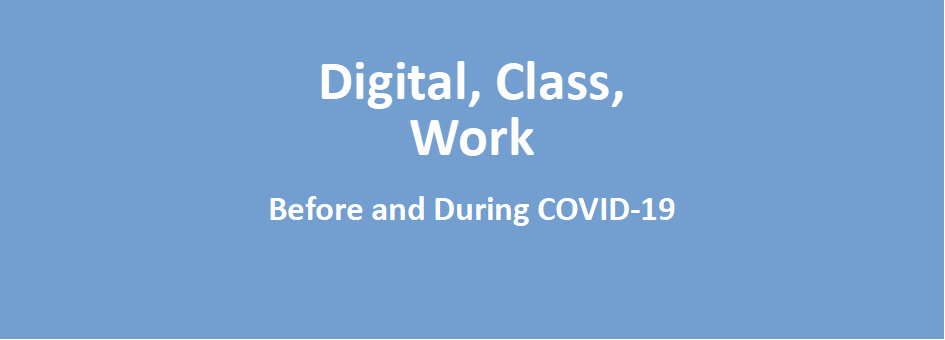By Michael Roberts
John Michael Roberts (no relation) is Professor of Sociology and Communications at Brunel University London. In his new book, Digital, Class, Work: Before and During COVID-19, Roberts argues that the pandemic has altered and fundamentally changed many social practices in society. “Nowhere is this more apparent than with the relationship between digital technology, labour and work.”
Roberts criticises those theorists who claim that this post-pandemic digital capitalism means that Marx’s theory of value and exploitation of labour is no longer relevant to the nature of class relations and oppression at work in modern societies.

For example, Hardt and Negri argue that exploitation is now located in numerous ‘non-factory’ spheres of social life; for example, in social media websites. To make this claim, however, Roberts says that they “conflate the exploitation of productive labour, based in the extraction of surplus value, with the oppression of unproductive labour, based in the extraction of surplus labour. Making this conflation enables some critical theorists to then argue that so-called ‘free labour’ of social media users acts as a type of ‘productive labour’ for capital.” But this so-called ‘free labour’ is not usually productive, nor does it, in most cases, create surplus value.
Roberts refers to Richard Horton writing in the medical journal, The Lancet, that it is still crucial to underline the social and class impact of COVID-19 because, ‘no matter how effective a treatment or protective a vaccine, the pursuit of a purely biomedical solution to COVID-19 will fail. Unless governments devise policies and programmes to reverse profound disparities, our societies will never be truly COVID-19 secure’.
The tendencies towards crises are not new
The COVID pandemic has triggered a new crisis in capitalism, but capitalism’s underlying tendencies leading towards such crises are not new. The exploitation of labour for the appropriation of surplus value remains the kernel of class relations even in the world of digital labour ie work that is processed and managed primarily through digital platforms where, in theory at least, there is often no need for workers to be together in a permanent physical space to carry out certain work tasks. Gig labour, as Roberts calls it, is still exploited in the same way as more traditional industrial labour.
Some argue that new digital technology has ushered in novel types of exploitation that blurs what were once thought to be taken-for-granted boundaries, such as the boundary between work and consumption. Others are less concerned about new forms of exploitation and instead claim that digital technology creates new types of cooperation and ‘co-creation’ between workers and users. Roberts concludes both views are one-sided accounts of more nuanced and complex labour and work processes. Roberts prefers an alternative framework based on Marx’s theory of alienated labour to digital labour and work.
In a way, Roberts reckons nothing has really changed. In the post-COVID world, the intensification, through digital media, of productive and unproductive labour processes continues. “This has involved implementing management strategies such as getting employees to work longer hours and complete more tasks during those hours, reducing wages, attacking yet more rights in the workplace, setting automated targets, monitoring the completion of these automated targets, tracking the movement of workers through digital media, and so on”. In other words, exploitation and oppression in the paid workplace is still the dominant method employed by capitalists to extract a surplus from their workforce.
Automation has led to a loss of jobs
Digital technology has been at the forefront of changing class relations in the productive sectors of the economy, and, in particular, attacking the rights of productive labour. It has led to the automation of many work-related tasks and has helped to downsize and replace jobs once undertaken by blue-collar unionised workers. Moreover, computer technology linked to skill polarization in the workforce has undermined workers’ solidarity, thereby reducing the likelihood of working-class cohesion and solidarity. Trade unions have over time been weakened, both by declining membership, but also by state legislation and attacks by employers that have sought to limit union power and influence. Rights for workers to engage in collective bargaining over wages and managers have been decimated. And digital technology has been an important weapon for the capitalist offensive against unions.
So the ‘old’ divisions between capital and labour are still very much with us, Roberts argues. A Marxist theory of digital technology, labour and work must therefore begin with the premise that the labour process is part and parcel of the capitalist mode of production and the creation of surplus value through alienated labour. The capitalist mode of production still has its fundamental contradiction: between the forces and relations of production; and between the production of use-values and the production of surplus value. This contradiction continues in the digital age in alienated labour and dispossession from control over the means of production. Plus ca change.
From the blog of Michael Roberts. The original, with all charts and hyperlinks, can be found here.



